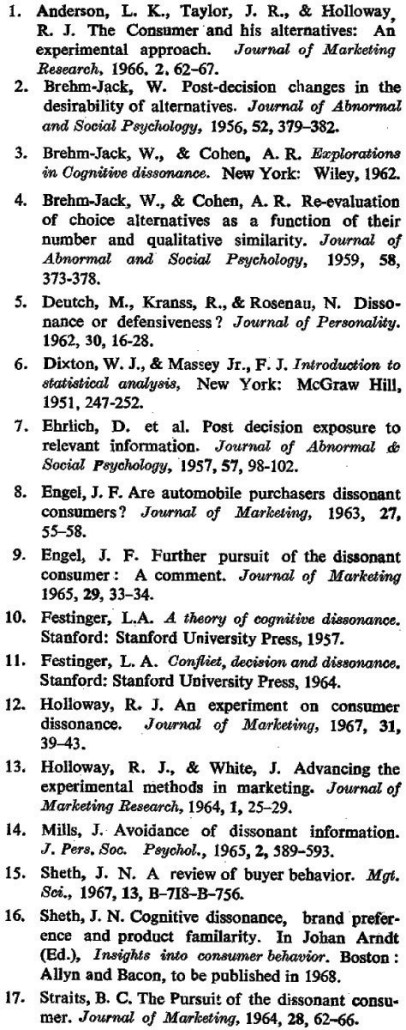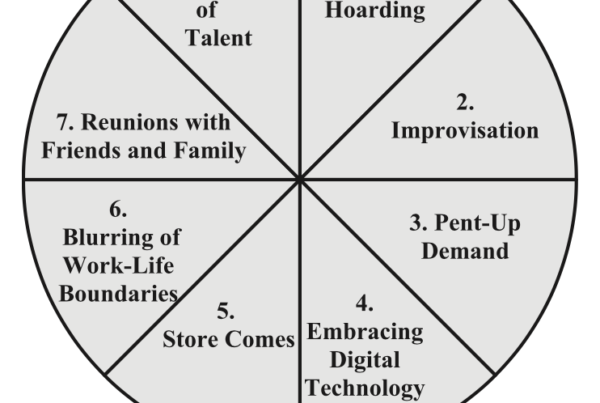Jagdish N. Sheth, Visiting Professor of Management, Colombia University, New York
The rapid and successful diffusion of the theory of cognitive dissonance (4,10,11) in many areas of social sciences including marketing can be attributed to its simplicity and potential for immediate practical implications. The basic notion of the theory Is that when two relevant cognition, (bit, of knowledge) arc dissonant (inconsistent) because one follows from the obverse of the other, a motivational tension is created. The aroused motivation impels the individual to reduce dissonance by making the relevant cognitions consonant (consistent). Several approaches, both internal and external to the individual experiencing the dissonance, are available which enable the individual to reduce dissonance.
In marketing, the theory of cognitive dissonance has been applied in understanding consumer behavior especially with regard to the post-decision restructuring of cognitions related to the choice alternatives involved in the decision (15). Essentially two broad approaches have been used by researchers in applying the dissonance theory. First, dissonance reduction after the choice decision Is considered an Internal process of restructuring cognitions which result in enhancement of the attractiveness of the chosen alternative and reduction In the attractiveness of the rejected alternative (2,3,5,11,13,14). Recently choice decision has been extended to more than two alternatives with the hypothesis that the greater the number of attractive alternatives, the more the dissonance after choosing one (1). The second research design utilizes some external environmental stimuli as facilitating device for the consumer to reduce post-decision dissonance. Most studies have used as readership or interest in advertisements of alternatives shortly after the choice as external approaches to dissonance reduction (7,8,9,14,17). The theory predicts greaser readership or interest in advertisements of the chosen alternative (it is consonant information) and avoidance of readership or less interest in the advertisements of the rejected alternatives (it is dissonant information).
The purpose of this article is to suggest that the magnitude of post-decision dissonance is at least partially influenced by the magnitude of preference of the alternatives involved in the choice decision. The greater the preference of two alternatives between which the consumer bat to choose the less will be the magnitude of post-decision dissonance. This hypothesis follows from the fact that most buying behavior is repetitive decision making in which the consumer establishes a preference hierarchy of alternatives. In other words, with repeated experiences the consumer learns the cognitions relevant in the decision making and structures them. Establishment of a preference hierarchy then enables the consumer to routinize his decision process and cut down on repeated information seeking. In the process, the magnitude of post-decision dissonance is reduced after each decision. The reduction may then result in no dissonance at all after the consumer has purchased product several times and probably has a strong brand preference also. It Is this strong brand preference which may be responsible for the lack of poet- decision dissonance in the Engel Study on automobile buying (8) in view of the fact that more than 60 percent of the respondents were repeat buyers of the same brand.
To summarize, the degree of preference of the alternatives in the choice decision influences the magnitude of post-decision dissonance. Furthermore, we must expect greater dissonance from a choice between two less preferred alternatives than from a choice between two more preferred alternatives.
Experimental Design
The experimental design of the study differed from the standard procedures used in studying past-decision dissonance in several ways,’ one of which was to use a set of national brands as choice alternatives in each of the three product classes chosen for the study. It was felt that brand choice within a product class would narrow the specificity of motives satisfied from purchase and consumption and also, would more accurately reflect varying degrees of preference since the consumer does in fact consider several brands as mutually exclusive alternatives in buying a product. In the past, studies have only used broad product classes as alternatives. For example, several varieties of playthings (toys) or recreation items (games) have often been used. The motives of the consumer, in the process, are kept at a highly general level, e.g., playing. The generality of motives is likely to create wide individual differences in the choice process which are ignored in the usual statistical analyses of testing the mean difference of ratings or rankings of alternatives from before to after the choice. By narrowing the choice to brands within a product class, we a priori create greater homogeneity among respondents.
Procedure
Subjects consisted of 50 male and 50 female students living in Cambridge, Massachusetts. Three products were included in the study each having II or 12 national brands. They were toothpaste, hair shampoo, and cigars. All the subjects were asked, as a part of marketing research, to rank order the brands of toothpaste in terms of their preference. Halt the subjects (25 male and 25 female) were then asked also to rank order the brands of hair shampoo in terms of their preference for the brands. The other half were asked to rank order the brands of cigars. Thus, each subject rank ordered a set of brands in two separate product classes.
The rank ordering of the brands in a product class in terms of the consumer’s preference in effect creates a preference continuum. The location of the brands on this continuum reflects different degrees of preferences. Then we may compare the effect of brand preference on post-decision dissonance if we ask part of the sample to choose from two brands closely placed but Dear the top of the continuum (say brands ranked 2 and 3) and ask the other part of the sample to choose from two closely spaced brands but near die bottom of the continuum (say brands 10 and 11). In fact, the two brands in a product class between which a subject had to choose in the study were ranked 2 and 3, 5 and 6, or 10 and 114 Thus, the choice was between two alternatives nearly equal in preference but located at different positions on the total preference continuum. The particular pair (2 and 3, Sand 6 or 10 and 11) was randomly assigned to each subject to each product class. A particular subject therefore, did not get the same rank positions to choose from for both the products.
All the brands of a product class were physically displayed on a table in front of each subject. The quantity and size of all the brands were approximately the same within each product class to avoid choice on these grounds. There was some time lapse in the experiment between the rank ordering and the choice of the brand during which the experimenter kept aside the two brands ranked 2 and 3, 5 and 6 or 10 and 11, and asked the respondent to choose between the two. This was felt necessary to avoid the automatic choice of the brand ranked higher than the alternative brand.
Three days after the first interview and choice, each subject was given the brand of his choice in each of the two product classes. Immediately after that, he was shown all the brands in each product class separately, and was asked to rank order them in terms of his preference for them.
The total number of choice decisions thus numbered 200, two for each subject. However owing to improper filling of the questionnaires, 3 male and one female subjects were discarded from the analysis. The final sample used thus was 96 subjects and 192 choice decisions.
Results
The manifestation of post-decision dissonance reduction is the change in rank position of the chosen brand and the rejected brand from before the choice to after the choice.
Festinger (10) states that the chosen alternative (brand) will become more attractive after the choice and therefore should be manifested in ranking it higher after the choice. Similarly, the rejected brand will be less attractive after the choice which could be manifested lit ranking it lower after the choice. In other words, the difference in rank position should have a positive sign for the chosen brand and a negative sign for the rejected brand.

Our hypothesis states that the greater she preference for the brands involved in choice decision, the less will be the post-decision dissonance. We should expect less change in brands which are ranked higher than in brands which are ranked lower. However, at each choice position, we should expect positive change for the chosen brand and negative change for the rejected brand in accordance with the theory. In abort, the magnitude of change in the direction predicted by the theory should be different at different choice positions on the preference continuum.
The data are analyzed with the use of the sign-test (6). The rank differences in the choice brands are either marked + if they move sip from the pre-choice to the post-choice ranking procedures or marked—if they moved down. Table I gives the frequency of +, —, and no change in the chosen brand among subjects who chose between ranks 2 and 3, 5 and 6, and 10 and II. All the differences are significant at .05 or less level of significance according to the sign-test. However, the changes in rank positions of the chosen brand are not equal at the three choice points.
First, more subjects did not change the rank position one way or the other if the brand chosen was ranked either 2 or 3 than if It was ranked 10 or 11. This tells us that the greater the preference for the brand involved in choice decision, the less is the tendency to change.
Second, the number of subjects, who changed the rank position in the positive direction, increases as we go from most preferred (ranks 2 or 3) to least preferred (ranks 10 or 11) alternative brands which Is another indication of the support of the hypothesis.
However, if we look at the change in the rank positions of the rejected brand in Table 2, the results contradict the hypothesis. According to the hypothesis, we must expect less change if the rejected brand is rank2or3 than if it was ranked 10 or II. The data in Table 2 do not bear this out. The magnitude of change (positive or negative) is much greater at the middle choice position (ranks 5 or 6) than at the extreme choice positions. In other words, we should have expected greater change at ranks 10 or 11: the hypothesis states a monotonic relation but the data reveal a non- monotonic relation. Furthermore, the relative frequency of negative and positive changes for ranks 10 or II is contrary to the theory in general Instead of obtaining more negative changes for the rejected alternative, we obtain slightly more positive changes.
There are several explanations for the contrary findings with respect to the rejected brand. Fir, there is a ceiling effect on the movement of brands which are placed at the extreme points on the ordinal continuum. This ceiling effect favors the hypothesis in the case of the chosen brand but it negates the hypothesis in the case of the rejected brand. A better procedure then would have bees to choose two positions (say ranks 3 and 4 or 7 and 8) only near the middle range of the continuum in place of the extreme positions. Secondly, it is very likely that the dissonance theory does not in fact produce symmetrical effects on the chosen and the rejected alternatives. A search in the literature reveals that only negligible attention has been paid to the changes in the rejected alternative (4, Pp. 36—42). It is then conceivable that dissonance theory has much better predictive power only with respect to the changes in the chosen alternative. Third, other sets of data collected in the study (16) show a tendency among subjects to form two subgroups: one which reduces dissonance by changing the rank position of the chosen brand as predicted by the theory, and another which reduces dissonance by changing the rank position of the rejected brand as predicted by the theory. However, the second group is not sizable as systematic as the first group lending further support to the second argument.
Summary
A study was undertaken to observe the influence of preference of alternatives involved in the choice decision on Lbs magnitude of post-decision dissonance. The hypothesis was that the greater the preference for the two alternatives between which choice was made, the less the magnitude of dissonance.
A total of 100 subjects (50 male and 50 female) were asked to rank order Ii to 12 national brands of two of the three products chosen for the study. Half the subjects (25 male and 25 female) rank ordered bands of toothpaste and hair shampoo separately according to their preference for the brands. The other half (25 male and 25 female) rank ordered brands of toothpaste and cigars. Each subject was then given a choice between ranked 2and3and5and6orl0andll, the specific choice positions on the preference ordinal continuum randomly assigned to him for each of the two products, Three days later, the brands he chose in the two-product classes were given to him, all the brands were displayed again, and another rank ordering was obtained.
The analysis of the data consisted of obtaining the number of positive (upward), negative (downward), or no movements in the rank positions of the chosen and the rejected brands. A sign-test on the positive and negative changes at rank positions 2 and 3, 5 and 6 and 10 and Ii supported the hypothesis in the case of the chosen brand but such a support was lacking in the case of the rejected brands. Several explanations, both methodological and substantive, are given for the negative findings.
References






